Cookie banner
We use cookies and other tracking technologies to improve your browsing experience on our site, show personalized content and targeted ads, analyze site traffic, and understand where our audiences come from. To learn more or opt-out, read our Cookie Policy . Please also read our Privacy Notice and Terms of Use , which became effective December 20, 2019.
By choosing I Accept , you consent to our use of cookies and other tracking technologies.

Site search
- Los Angeles
- San Francisco
- Archive.curbed.com
- Homes for rent
- Homes for sale
- Curbed Comparisons
- Neighborhoods
- Development
- Architecture
- Historic Preservation
- Transportation
Filed under:
- Chicago Transportation
- Transportation Week
A walk through the Pedway: Mastering the Loop’s network of underground tunnels
A lifesaver or pedestrian purgatory?
/cdn.vox-cdn.com/uploads/chorus_image/image/56791947/shutterstock_1026971659.1506013810.jpg)
Chicago is known for a variety of transportation: busy airports , a popular riverfront , and a strategic rail transit hub . However, the city’s downtown is perhaps best traveled by foot. It’s the only way to explore a series of underground tunnels and bridges known as the Pedway that link more than 40 blocks in the Loop.
Plus, knowledge of the underground path comes in handy during the city’s extreme cold and unpredictable seasons. Tens of thousands of travelers use parts of the roughly five-mile pathway everyday which connects to CTA stations, public buildings, and private offices, according to the city.
Despite living in Chicago for almost two decades, I find myself chronically underdressed each winter and usually in need of protection for impractical footwear making it from the L to meetings that take place in the Loop. For this reason, I have become quite familiar with the downtown Pedway system.
:no_upscale()/cdn.vox-cdn.com/uploads/chorus_asset/file/14561292/shutterstock_1026971854.jpg)
History of Chicago’s underground tunnel system
The Chicago Pedestrian Walkway System works in conjunction with street level paths that connect to almost 50 buildings in the Loop. The longest continuous section of the Pedway runs east-west from 120 N. LaSalle Street to the Millennium Park near Columbus Drive and Randolph Street with various points radiating north and south.
The system includes several shorter sections, at times serving only as a connection between buildings and CTA or Metra Stations. Nearly every civically significant building in the Loop, including City Hall and the James R. Thompson Center, is connected by a section of the Pedway.
The system opened in 1951 with the completion of tunnel between the Milwaukee-Dearborn Subway and the State Street Subway, connecting what is now the Red and Blue lines. In 1966, the former Brunswick Building at 69 W. Washington Street was linked to the Civic Center. Then in late 1980s a connection was made to the Millennium Metra station which was completed in 2005. Another extension of the Pedway was added in 2010 which opened up access to north of Lake Street to Aqua Tower.
While the notion of an indoor pedestrian subway in Chicago existed as early as the 1920s, it took the success of indoor suburban malls and the transition of State Street from that ‘Great Street’ to a series of discount stores, pawn shops, and burlesque theaters to encourage city planners to push for all-weather pedestrian walkways. Several comprehensive plans presented in the late 1960s urged Chicago to consider connecting commercial and civic buildings in the Loop.
In its primary civic role, the Pedway allows underground access between City Hall, the Daley Center, the Cook County Office Building, and the Thompson Center which bridges these government buildings. It also provides ingress to the private sector and public citizens to Daley Center Court rooms, offices of the Cook County Clerk, and the Central Illinois Secretary of State Facility. Between these are a super colony of businesses, including dry cleaners, salons, shoe repair shops, and restaurants and bars.
However, the Pedway has issues with inconsistent signage and an official map that lacks dozens of informal pathways. Some of these walkways are through private property or in many cases across commuter or rapid transit train platforms. Many Pedway routes are marked with blue and yellow compasses set into the terrazzo floor, but others are designed to match the colors and aesthetic of the building it connects to which can be misleading.
Some areas of the Pedway are aggressively patrolled with staff and cameras, while others appear to be entirely void of any attention. As sections of the Pedway are operated by individual building owners, not all doors remain open in the evenings or weekends.
:no_upscale()/cdn.vox-cdn.com/uploads/chorus_asset/file/9296299/IMG_6255_17.jpeg)
A walk through the Chicago Pedway
Earlier this week, I descended into the Chicago Pedway beneath the Roger Brown mural of Daedalus & Icarus at 120 North LaSalle, towards City Hall and the County Building, where the entrance was clearly marked with the Pedway system compass. This is a good sign, I thought. As the Pedway travels beneath buildings, it reflects the building just above through matching designs or materials, providing a more kickable example of the architecture, as the Pedway is public space. In the case of 120 North LaSalle, the same gray-black marble is repeated in the hallway, transitioning through a steel doorway to the City side of the City Hall/County Building, where the walls are tiled in the black and grey of the Chicago Police Department.
Cadet training occurs in this area of the basement of City Hall, as well as case research. There’s also a bike room down there for city employees. The Pedway forces itself upstairs from here, and into the first-floor lobby of the City Hall/County Building. The path continues into the county building, and down an escalator facing east to Clark Street. Getting back into the Pedway when it is no longer underground can be tricky. This was my first instance of mild confusion, but I learned that my intuition to head to the down escalator was a good one.
The bowels of the Daley Center mimic the building above, including glossy terrazzo floors, tan Roman brick and plate glass—something like the International Style gone casual. The foot traffic really picks up in this portion of the Pedway, as Chicagoans make their way to file forms, apply for licenses, obtain certificates and go to court. The directory within this area is a useless piece of brass, indicating that picnic permits could be obtained if one walks towards the direction of a solid brick wall.
:no_upscale()/cdn.vox-cdn.com/uploads/chorus_asset/file/9296313/IMG_6235_6.jpeg)
I observed a nervous woman in an Anthony Rizzo jersey briefly checking out the directory before bolting in the direction of the George W. Dunne Cook County Office Building, only to suddenly pivot on a clipped expletive before turning around in the opposite direction.
Next to the Liquor License Appeal Commission Offices, is a Starbucks with a tiny patio, quietly piping music into the heavily cooled air. The Pedway is known as a welcome respite from the harsh winds and cold winters, but it can also provide relief from late summer heat.
The Pedway splits off here, with one branch headed towards the Dunne Office Building and the other headed towards the Red Line and Block 37.
Within the George W. Dunne Cook County Office Building are the Pedway shops including Angileri’s Barber Shop, Around the Clock Repair, and an entrance to Trattoria No. 10. Doubling back towards the east end of the Pedway is the mezzanine to the State Street Subway, Block 37, and the Red Line near Macy’s.
This portion of the Chicago Pedway dates to 1989, but was brightened in 2013 by the addition of 22 art glass windows. The collection, once part of the Smith Museum of Stained Glass Windows at Navy Pier, includes designers part of the American Victorian stained glass movement like Louis Comfort Tiffany. Here, the omnipresent florescent light of the rest of the Pedway is replaced by brilliantly colored faceted glass set into innovative compositions and lit from behind.
:no_upscale()/cdn.vox-cdn.com/uploads/chorus_asset/file/9296343/IMG_6241_4.jpeg)
Nearby, the entrance to the Cultural Center is marked by a simple postmodern rotunda, perhaps evocative of the treasures within the building, such as the Grand Army of the Republic Hall and Preston Bradley Hall, home of a 38-foot Tiffany Favrile glass dome. Both spaces are within the same building but represent two distinct decorative moods.
East of the Cultural Center and heading towards Millennium Station, the Pedway takes a dark turn. The nearly 20-year effort to turn the cavernous, dank underground of Millennium Station into a modern terminal didn’t affect all of the spaces, and many still appear to be under construction, particularly the musty and littered entrance corridors. Bare concrete floors and dusty utility lights give way to the Millennium Station Concourse, with its cool blue terrazzo floor with pedestrian lanes, a gentle design reminder to keep movement orderly while moving through the space during rush hour.
:no_upscale()/cdn.vox-cdn.com/uploads/chorus_asset/file/9296375/IMG_6252_2.jpeg)
Close to 20,000 people board Metra and South Shore Line trains daily, many of them working the Pedway to shave off precious seconds from their commute from offices downtown to awaiting trains. Fans of the Batman franchise will remember this area from 2008’s The Dark Knight. Batman sped through the concourse on the Batpod with the same ferocity as a sneaker and white tube sock suburbanite, frantic to catch her Union Pacific Northwest to Arlington Heights that leaves at 5:05 p.m.
Mbar, within the station, and perhaps the Pedway’s only official bar (as Infields is technically located inside Macy’s), provides commuters with drinks and snacks before their rides home. I watched a weary professional order an “extra-large Chard” from the bartender, who emptied out the cold coffee from her mug and filled it with Chardonnay, as travelers on commuter trains may choose to take their beverages to go.
North of Lake Street and accessible only above ground, is the second largest segment of the Pedway, connecting Michigan Plaza at 205 N. Michigan Avenue, to the Swissotel Chicago. The western-most entry point to this portion of the Pedway was difficult to find. I initially followed the wrong escalator down once inside Michigan Plaza and into a private area where I was chastised for taking a photograph of a particularly unhelpful sign.
:no_upscale()/cdn.vox-cdn.com/uploads/chorus_asset/file/9296463/IMG_6215_11.jpeg)
The Pedway here, toted by neighbors as beneath the New East Side micro neighborhood, extends to several hotels, including the Fairmont Hotel and the Hyatt Regency, and takes on a decidedly different character than the larger portion of the Pedway. Spaces along this stretch are cleaner and carpeted, and have more in common with hotel hallways than the larger portion of the Pedway connecting civic and commercial buildings.
With only three residential buildings boasting connections to the Pedway, specifically the Heritage at Millennium Park, the Park Millennium, and Aqua Tower, residents of the area were disappointed that the Pedway did not continue east once it was connected to Aqua in 2009. Despite the limited access to residential developments, this area of the Pedway seems popular with young parents and dog owners during the day, as I dodged several sleepy toddlers in strollers and joyful terriers.
:no_upscale()/cdn.vox-cdn.com/uploads/chorus_asset/file/9296475/IMG_6251_3.jpeg)
The route became particularly confusing as I approached the Hyatt Regency, where several entrances and pathways are unmarked. Twice I ended up going down the wrong hallway and was plunged into the perpetual darkness of Lower Wacker Drive with no Pedway compass in sight. Here I ran into a young man who seemed to lose all hope in finding the Central Auto Pound. Was this some sort of pedestrian purgatory?
I asked a parking lot security guard for directions back down into the Pedway, heading south on lower Columbus Drive at his suggestion. When I arrived at what I heard to be the entrance to the Pedway, I found a stairway leading up. Did the security guard mistake my question about the Pedway entrance as one asking how to just simply get out of here?
:no_upscale()/cdn.vox-cdn.com/uploads/chorus_asset/file/9296781/IMG_6260.jpeg)
I ascended the steps onto upper Columbus Drive, a street full of hotels, commercial buildings and general pedestrian unfriendliness that is more evocative of suburban Schaumburg than the Loop. Following an escalator down into the Pedway connected to Aqua, back on track towards the Swisshotel.
I thought about the simplicity of Chicago’s street grid system, creating a zero point at State and Madison streets that has assisted Chicagoans to get where they are going since 1909, against the intricacies and colloquial habits of the Pedway system.
There is room for improvement, particularly in terms of increasing the number of signs and making them consistent overall, but with three levels to Wacker Drive, neighborhoods and the grid system slashed by highways, diagonal streets and boulevards, knowing how to get around in Chicago is often an experience that maps and signs cannot teach. The only way to master the Chicago Pedway is on foot racking up the underground miles step by step.
Next Up In Chicago Transportation
- Chicago traffic was the second worst in the nation in 2019, says new report
- Electric scooters are coming back to Chicago. Here’s what the city learned.
- Here’s why you should bike year-round in Chicago. Even in winter.
- Chicago’s new transportation commissioner comes from architecture firm Studio Gang
- Chicago is getting more bus-only lanes. Could they alleviate congestion?
- Chicago’s new ride-hailing tax begins now, and it’s the country’s highest fee
Loading comments...
Share this story.
Gapers Block has ceased publication.
Gapers Block published from April 22, 2003 to Jan. 1, 2016. The site will remain up in archive form. Please visit Third Coast Review , a new site by several GB alumni. ✶ Thank you for your readership and contributions. ✶
Friday, April 26
Feb 13 2004
Subterranean city: a tour of chicago's pedway (part 1).
By Alice Maggio
The Pedway is often called Chicago's secret weapon against the elements. Made up of a combination of underground tunnels, concourses and overhead skyway bridges, the pedestrian walkway network provides shelter from all types of inclement weather in and around the Loop.
Laid end to end, the Pedway stretches nearly 40 city blocks, but the network is not completely interconnected. Instead, it consists of two major sections. The first, and largest, section connects over two dozen city, office and commercial buildings in the Loop while also providing access to CTA and Metra train stations. The second major section links several buildings east of Michigan Avenue, just south of the Chicago River. Currently, one can walk from the James R. Thompson Center to Marshall Field's, the Cultural Center and over to the Prudential Plaza without ever having to step outside.
Development of the Pedway began in 1951 when the city built the one-block tunnels between State and Dearborn connecting the Red and Blue Line CTA stations at both the Washington and Jackson stops. Over the following decades, the Pedway grew haphazardly as both the city and private developers expanded the system, and even today the network continues to grow and be improved. As a result of its unsystematic construction, the Pedway lacks design uniformity, and every section of the network has its own unique characteristics.
The lack of systematic organization, however, also means the Pedway can be difficult to navigate or even locate. When people call it the city's secret weapon against inclement weather, the emphasis is on "secret." Entrances to the Pedway are frequently unmarked, and signage within the system is sparse, misleading or nonexistent. To make matters worse, print maps of the Pedway are currently unavailable, and new maps will not be published until reconstruction is completed on a tunnel connecting Marshall Field's and the Cultural Center.
Pedway novices need to have a sense of adventure and a little patience to be able to navigate this tangled web of tunnels, corridors, staircases and revolving doors. Follow along, then, as this tour guides you through the maze and introduces you to just some of the sights, services and shopping that can be found in this subterranean city. But, before embarking on your own Pedway adventure, be aware that while connections to the train stations are open 24 hours, access to the complete Pedway network is generally available only from 6am to 6pm.
The tour begins at the Red Line CTA station at State and Washington. If you arrive by train, when you leave the train, be sure to go up the north stairs towards Randolph Street. Exit through the turnstiles. Most people hurry straight up one of the stairways to street level after exiting, but stop and observe for a moment. This El station sits squarely in the middle of the Pedway. On the east side of the station, a revolving door leads into the lower level of Marshall Field's while on the other end of the station, an arrow on the floor with the words, "West to Pedway," points towards a long underground corridor.
Fig1. The compass in the terrazzo floor tells you where to go.
For now, head west down the corridor (we'll visit the eastern half next week). This block-long passage is one of the two tunnels completed in 1951 that first made up the Pedway. It connects the Red Line Washington El station on State Street to the Blue Line Washington station on Dearborn and is one of the busiest sections of the Pedway. In 1995, the Chicago Department of Transportation estimated up to 20,000 people a day use this tunnel, but during the winter months that number doubles. The tunnel is unheated so it is not exactly comfortable, but at least you are protected from the wind and snow.
Walk through the Blue Line CTA station at the other end of the corridor until you come to two sets of revolving doors. You have reached the Richard J. Daley Center (50 W. Washington). An open stairway on your left leads up to Dearborn Street and Daley Plaza, home of Chicago's famed Picasso sculpture. Enter the Pedway beneath the Daley Center and immediately notice this section is heated.
The Daley Center is largely occupied with courts and court-related offices. The Circuit Court of Cook County occupies half the building with over a hundred courtrooms, and one may also find the Appellate and Illinois Supreme Court here. The Pedway beneath the Daley Center is wide, well-lit and filled with mid-morning crowds. As you enter this section, you will find a Starbucks coffee shop immediately to your right. Yes, the coffee chain that everyone loves to hate has even penetrated underground. Across the hall, Ace Shoe Clinic is doing brisk business polishing the footwear of the lawyers and city officials that dominate the Pedway crowd here. The Daley Center Pedway is also home to the large and inviting West Egg Cafe, open for breakfast and lunch. An escalator near the cafe leads up to the lobby of the Daley Center.
The Pedway here splits into two branches. One corridor continues west while a second hallway now leads south. Take the hallway south and find the Traffic Court and traffic safety school on the Pedway and another stairway leading up outside to Daley Plaza.
Fig2. You could leave the Pedway here, but you'd miss the rest of the tour.
Continuing south, go through another revolving door at the end of the hall into the Pedway beneath the Cook County Administration Building (69 W. Washington). The building is home to many city and county offices. The building was temporarily vacated when a tragic fire on October 17, 2003 resulted in the deaths of six people, but the building has since been re-occupied. This section of the Pedway is more narrow and dimly-lit than the Daley Center, but several businesses and services are located down here. You will find the Early Edition newsstand and convenience store, a barber shop/nail salon and Dairy Queen. In addition, Around the Clock repairs watches, clocks and jewelry. The Pedway beneath the Cook County Administration Building also includes the super-secret Secretary of State Express Facility. Though currently closed for renovations, this facility is the place to go to get your driver's license renewed without having to wait in line.
Keep following the Pedway past the Secretary of State facility and down a short flight of steps. On your left a revolving door leads to the Washington Blue Line CTA station between Washington and Madison on Dearborn. Instead, go through the revolving doors on your right and up an escalator to the street-level lobby of Three First National Plaza. Cross the lobby and stop to admire the large bronze Henry Moore sculpture. If you are feeling really ambitious, continue upstairs and locate the Skyway bridge that crosses Madison Street to One First National Plaza, home to the offices of Bank One (though maybe not for much longer). In One First National Plaza, head down to the first floor and locate the escalator in the southeast corner of the lobby. The Pedway continues down this escalator, leading to the Monroe station of the Blue Line, where this particular branch of the Pedway effectively ends.
Retrace your steps back to the Daley Center and take the Pedway corridor heading west. This hallway is lined with display cases. On the south wall (your left), an exhibit presented by the Theatre Historical Society of America entitled, "Chicago Celebrates Three Centuries of Theatres," features photographs and ephemera from some of the city's most well-known theatre buildings. On the north wall, don't miss the oil stick drawings by artist Theolia Norwood executed on the flattened lids of corrugated cardboard file boxes.
Pass additional stairways leading up to the east side of Daley Plaza and go through the revolving doors at the end of the hall. On your right as you pass through the door is a small concession area run by the Department of Rehabilitation Services' Vending Facility Program for the Blind which, as the name implies, is operated by individuals who are blind. On the opposite wall, marvel at having found a map of the Pedway. Take a moment to re-orient yourself and commit the map to memory as it is one of the only ones you will encounter in the system. Now, as the Pedway appears to end here, head up the escalator.
The escalator leads into the beautiful lobby of the City Hall/County Building which, although it is really one building, is treated as if it were two separate structures in order to confuse people. This monumental Classical Revival building was completed in 1911 and takes up the entire city block. City Hall occupies the west half of the building at 121 N. LaSalle, while the east half is considered the County Building at 118 N. Clark. Walk through the lobby and admire the vaulted ceilings covered with Bottocino marble, the mosaic ornamentation and relief sculptures.
Fig3. One of the rare maps of the Pedway.
In the center of the lobby, notice an elevator prominently marked with a sign reading, "Pedway." Do not be tempted to take this elevator. Although it does lead to an underground corridor that connects City Hall to the Savings of America Tower across the street at 120 N. LaSalle, the passage is narrow, deserted and leaves one with the distinct feeling that "Maybe-I-Shouldn't-Be-Down-Here." Instead, walk across the lobby towards the north exit of the City Hall/County Building to find the Pedway link to the State of Illinois Center. Pass through a set of doors into the outer foyer of the building, locate the stairway to your right and descend into the next section of the Pedway.
The lower level of the City Hall/County Building includes several important offices and services. An annex office of the City Clerk on the Pedway is the best place to get your passport renewed without waiting in line. You will also find the Cook County Vital Statistics office down here where you can obtain birth, marriage and death certificates. Finally, the Marriage Bureau is down the hall from the Vital Statistics office for completing applications for a marriage license and domestic partnership registration.
Walk north past these offices and down the tunnel that passes under Randolph Street until you find yourself in the lower level of the State of Illinois Center, also known as the James R. Thompson Center. The Center was designed by architect Helmut Jahn and was completed in 1985; the glass and steel curvilinear structure is home to several dozen state agencies. As you enter the Thompson Center from the Pedway, a full-service Secretary of State facility is immediately to your left, and it is crowded as usual. You can also access the CTA Clark/Lake El station from the lower level. The vast majority of the floor, however, is occupied by the Center's food court -- cleverly named "The Great State Fare." Just about every major fast food chain is represented here, and at 11:30am the space is already filling with early lunchtime crowds.
Find an empty table, take a break and do some people-watching because you have largely finished exploring the western half of the Pedway network. To continue your adventure, retrace your steps and return to Red Line El station at State and Washington where the tour began.
Next week: The eastern half of the Pedway.
About the Author(s)
Alice Maggio , our resident librarian, also writes at That Rabbit Girl .
Recently on Detour
A Tragic Day in Chicago While most people see the weekend after Thanksgiving as a time to begin preparations for the December holiday season, this time of year is a painful reminder to some as the anniversary of one of Chicago's deadliest fires. Ninety-two students...
The Social Life of Our Urban Spaces "Placemaking" comes to Chicago
Don't '&' Me, OK? The ampersand gets Wenner thinking about the distinction between race and ethnicity.
Photo Essay: Transitions Rearview contributers interpret the theme "Transitions."
People from the Rearview Archive Gapers Block digs into the Rearview archive in search of portraits.
GB Buttons $1.50 Shipping included
GB T-Shirt $12 Shipping included
I ✶ Chi T-Shirts $15 Shipping included
This website uses cookies to improve your browsing experience and analyze the use of the website. Learn More

Chicago Pedway Tour

Tour Information
Pedway tour, pedway tour highlights.
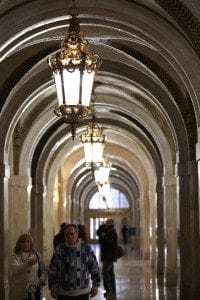
Construction of this labyrinth began in 1951 to simply connect the Red and Blue line subway/'L' train stops. Now it connects over 50 buildings, 40 blocks, and 5 miles of pathways.
While on this tour, we will see Chicago's famous architecture while peering out of the windows of intricate lobbies, amazing examples of art, and we'll discover some of the best "secret-eats" in the city- all while enjoying the comfort of the temperature regulated pathways!
Sites on the Chicago Pedway Tour:
- The Wrigley Building
- Trump Tower
- The Marina Towers
- The Leo Burnett Lobby
- The Thompson Center
- Stained Glass Museum (Temporary)
- The Cultural Center
Tour information
Reservations: REQUIRED. Click here to reserve . Groups of 9 or more must contact us before booking.
Where: Directly inside of the Wow Bao at 1 W Wacker Dr, Chicago, IL 60601.
Duration: Tour lasts approx. 2 hours. Total walking is just over one mile (1.6km).
When: View our Calendar . Tours are on U.S. Central Standard Time. This tour is offered seasonally only.
Cost: This tour is free to take, and you get to decide what, if anything, the tour was worth when it's done. A name-your-own-price tour is a tour for anyone's budget.
And much, much more
North america, united kingdom & ireland, middle east & india, asia & oceania.

Behind the tour: The Chicago Pedway

Have you ever wondered what inspires a CAC tour? On our tours of the Pedway, you can explore more than 40 downtown blocks with shops, restaurants and public works of art, part of an underground system of tunnels known as the “city under the city.”
by Nikki Snodgrass, Media Relations Manager
The City Under the City
There’s a reason why Chicago’s Pedway is considered an urban environment all to itself. And while thousands of Chicagoans venture underground every day during their commute, to do some shopping or just to escape the elements, there’s a lot that isn’t commonly known about this unique set of downtown pathways. Lorie Westerman is a CAC docent , a Pedway tour director, and the designer of CAC’s Pedway tours. She became fascinated by the Pedway when she moved to the city in 2003 and decided to delve into the story behind how it came to be.
Winter in Chicago can make navigating downtown a challenge, even for lifelong residents of the city. Because CAC offers tours year-round—tours that depart rain or shine—we wanted to bring tour-takers an option that would be an architectural and historical experience, as well as a perfect fit for the colder months. Those who weren’t directly familiar with the path of the Pedway found the idea of the journey a bit intimidating. In fact, CAC learned that even some Chicagoans who’d worked in buildings along the Pedway for years weren’t aware of the “secret” underground passage. That’s when Westerman set out to see what she could discover.
Getting to the Bottom of It
At the time, public information about the Pedway was sort of tough to find. Eventually, Westerman got in touch with a Chicago Department of Transportation board member, who also happened to be Chicago’s Pedway liaison. Provided with a plethora of old files and research materials, Westerman started sifting, intent on turning up the points of interest that would make for intriguing Pedway tour content. By 2012, after Westerman’s daunting task was complete, CAC was ready to introduce people to Chicago’s downtown underground. Take a look at some of the “Did you know?” facts that Westerman uncovered.
- Construction of the Pedway began in 1951, and expansion continues to this day.
- Among the busiest sections of the Pedway is the block-long passage that connects the Red Line Washington L station on State Street to the Blue Line Washington L station on Dearborn.
- There are actually two Pedway systems. Heading in one direction , you’ll travel past buildings including the Prudential Center, Aon Center and the Fairmont Hotel; in the other direction , there’s the Thompson Center , the Leo Burnett Building and the Renaissance Hotel.
- You can walk the entire Pedway without ever ending up outdoors.
So has the weather got you down? Do you need to know how to get from the Millennium Park Shops to One Illinois Center via the Metra platform? Want to find out what Lori Westerman calls the “Where the Heck Am I?” building? Then join us for a fascinating subterranean excursion into one of Chicago’s best-kept secrets.

Take the Tour
Pedway east.
Experience a warm walk through cool architecture in Chicago’s “city under the city.”
Explore Chicago's Mysterious Tunnel System With This Tour
Chicago has an underground system called the Pedway connecting the downtown buildings - take this tour to explore it.
Like Canada's Toronto and Montreal, Chicago is cold in the winter - so who wants to go outside in the freezing weather between office blocks? Like those Canadian cities, Chicago has developed an underground network that connect the central business district of Chicago that especially comes in handy in the winter.
Montreal in particular has a whole extra city beneath it where the residents of the cold city can escape the chills of winter. London has a very different network of tunnels beneath its streets - it has many abandoned tube lines and stations, many old postal tunnels, and many abandoned or secret military tunnels. In all London is considered to have one of the largest tunnel systems in the world.
What To Know About Chicago Pedway
The Chicago Pedway connects the train stations, hotels, skyscrapers, and some retail stores in the central business district. The Pedway is complete with restaurants, art, shops, and more. The system helps to protect pedestrians from inclement weather as well as to bypass having to wait for stop lights on the surface. The whole length of the Pedway is over 40 downtown blocks.
- Links: More Than 40 Blocks In The CBD
- Buildings: Over 50 Buildings
- Built: From 1951
Most of the connections to the Pedway are commercial or government buildings. It is made up of a system of underground tunnels and overhead bridges. Every day tens of thousands of people used the Pedway as they make their way to can from work or to and from shopping centers.
The development of the Pedway started back in 1951 as the City of Chicago built one-block tunnels connecting the Red Line and Blue Line subways at Washington Street and Jackson Boulevard. Today it has been greatly expanded with both private and public investment so that it connects more than 50 buildings.
The Pedway offers a safe, convenient, and quick way for people to get around downtown and is particularly appreciated in the winter months and when its windy or snowing.
Related: It's Rumored That London Is Home To The Largest Secret Tunnel System In The World, So Here's What We Know
Why Take A Guided Tour Of The Pedway
Inside Chicago offers a range of walking tours of the Windy City. Their "Open Your Eyes" tour explores Chicago's Underground Pedway as well as other secrets of the loop. On this tour, one will explore the Pedway, its history, and see some surprisingly beautiful architecture interiors below the surface.
See how the people of Chicago manage to keep warm and dry in adverse weather by means of the mysterious underground tunnels of the downtown.
There is an underground world beneath Chicago with corridors of stained-glass and underground swimming pools. The knowledgeable Chicago guides show their guests hidden passages, rich symbolism, strange stories, and overlooked details of the Pedway that will add to the charm and character of Chicago as a whole.
What better way to see the hidden and inner side of Chicago, than by exploring the Chicago beneath the streets? While the Pedway is not exactly a noted tourist attraction for Chicago, it is an opportunity to see a very different side of one of America's largest and coldest cities.
More than just the pedway.
The tour explores more than just the Pedway and underground tunnels. It also covers some of the above ground secrets of Chicago. Some of these "secrets" are hidden in plain sight - who's ever noticed the giant green gargoyles on the library?
The tour ends with the "secret" interior of the Art Institute where guests are well positioned to explore more of downtown Chicago after the tour.
- Cost: Adults $30.00, Children $25.00
- Duration: Around 2 Hours
- Distance: Around 1.5 Miles Of Walking
- Group Size: Up To 15 People
- Offered: 2.00 pm Fridays & Saturdays
- Note: The Exact Route Can Change Depending On Building's Hours of Operation (Some May Be Closed On The Weekend)
The tour is also available as a private tour. For those would like to convert it to a private tour contact Hillary at 312-799-0164 to get it organized.
Related: What You Need To Know About Seeing The Sealed Up Freight Tunnels Under Chicago
The Sealed Up Freight Tunnels of Chicago
Chicago has more secrets than one might guess, it also has a warren of abandoned tunnels. These are mostly 2-foot narrow-gauge railway freight tunnels that have since been abandoned.
- Original Purpose: For A Network Of Telephone Cables
- Later Purpose: For Freight And Mail Service
- Length: By 1914 They Were Around 60 Miles or 97 Kilometers Long
The tunnels started to be built in somewhat secrecy in 1899 and by 1914 there were 50 miles of these tunnels beneath the city. Today they are abandoned and sealed off.

- Restaurants
- Home & Decor
- Architecture
- Art Galleries
- Discount Tickets
- Museums & Attractions
- Health & Beauty
- Submit an Event
- Products We Love
Naperville Artisan Market – Sat & Sun, May 18-19, 2024 at…
Oak brook artisan market – village green at oakbrook center (jun…, chicago artisan market in fulton market (sun, jul 14, 2024), north shore artisan market – village green park, northbrook, il –….
- Entertainment
Underground Chicago Walking Tour of the Pedway
American Walks - Daley Center - SE corner of Clark & Randolph St., Chicago, IL 60612

The Underground Chicago Walk is a tour through Chicago’s pedway, a little-known underground tunnel system in the heart of downtown Chicago — with food samples included. It may sound scary but fear not, the recently rehabbed tunnels are used by thousands of savvy locals every day.
Purchase half-price tickets to this event.
Start Date: Thursday, February 13, 2020 End Date: Friday, August 28, 2020 Time: varies by date Location: American Walks – Daley Center – SE corner of Clark & Randolph St., Chicago, IL 60612 Cost: $25 (Ticketing processing fees apply.)
Additional dates and times may be available. Times and prices vary by date. Please view ticketing page for details. * Exact meetup location is confirmed when reservations are made. *
The pedway connects many of Chicago’s beloved landmarks, like Macy’s (Marshall Field’s), The Thompson Center, Block 37, The Daley Center, Millennium Park, City Hall and many more. Miles of new tunnels have been opened, with miles more in the works. Come explore the underground tunnels while sampling food at some of the unique restaurants, cafes and shops the pedway has to offer. You’ll sample artisan grilled cheese sandwiches, frozen kefir, traditional Thai cuisine, Garrett’s popcorn (a treat bag of their famous “Garrett’s Mix”), a wine tasting at Macy’s wine shop (Friday tours only) and a stop at Macy’s Candy Kitchen. The tour stops by the unexpected underground American Victorian stained glass art exhibit and ends in the Chicago Cultural Center, home to the world’s largest Tiffany dome glass ceiling. Give yourself some extra time after the tour – which is updated for winter to keep you inside and warm – to take in one or all of the Cultural Center’s free art exhibits. Note that meeting locations change frequently and you will be given the correct meeting location after you book a specific date.
More half-price, discount and pre-sale theater tickets, comedy, musicals and more.
Discount Parking: StyleChicago.com recommends booking convenient & affordable parking in advance through SpotHero , the nation?s leading parking reservation app & website.
More fun things to do in Chicago * StyleChicago.com’s 13th annual Resolutions 2020 at the W Chicago – City Center * Chicago Artisan Market – Sun, March 8th at Morgan MFG
- Submit a Business
- Terms and Conditions
Chicago Pedway

Most Recent: Reviews ordered by most recent publish date in descending order.
Detailed Reviews: Reviews ordered by recency and descriptiveness of user-identified themes such as wait time, length of visit, general tips, and location information.

Also popular with travelers
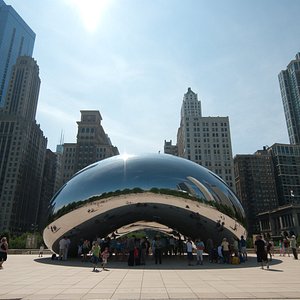
Chicago Pedway - All You Need to Know BEFORE You Go (2024)
- Chicago: Architecture, History & Highlights Small Group Tour (From $59.00)
- Chicago in a Day: Food, History and Architecture Walking Tour (From $131.54)
- Chicago Favorites Food & Walking Tour plus FREE Bike/Kayak Rental (From $79.99)
- Chicago Architecture & Highlights with Local Treat - Small Group Walking Tour (From $138.00)
- Day in Chicago Food and Architecture (From $272.50)
- (0.17 mi) Loews Chicago Hotel
- (0.14 mi) The St. Regis Chicago
- (0.16 mi) Sheraton Grand Chicago Riverwalk
- (0.21 mi) Swissotel Chicago
- (0.40 mi) Hotel EMC2, Autograph Collection
- (0.10 mi) Pinstripes
- (0.09 mi) Robert's Pizza and Dough Company
- (0.11 mi) Molly's Cupcakes
- (0.11 mi) Lizzie McNeill's Irish Pub
- (0.11 mi) Pinched On The River
Chicago Pedway: Getting Around Town Underground
Chicago is a great walking city — even if you’re walking underground. .
With Chicago’s Pedestrian Walkway system (Pedway), a six-mile system of underground tunnels, pathways and connected corridors, it’s possible to walk from one side of the Loop to the other without encountering traffic, nasty weather, special events or other obstacles. The uncrowded, roof-protected, climate-controlled Pedway is the way to go. It is one of Chicago’s unique “hidden” gems.
And it takes you to a lot of interesting places. The following is a list of highlights encountered on our company’s Pedway tour throughout downtown Chicago:
Small Retail Shops
One of the delights of the Pedway is that some corridors feature a wide array of small retailers — a grilled cheese sandwich stop, a small tavern, doughnut shops, shoe repair, convenience stores, barber shops, and beauty salons. If you enjoy the look and feel of small-town America, these sections of the Pedway are for you.
Fitness Centers
A handful of fitness centers/clubs are accessible via the Pedway. At Randolph and Wabash is an LA Fitness with an indoor swimming pool that is accessible from the Pedway. In the Lakeshore East neighborhood (east of Michigan Ave. and north of Randolph St.) is the Lakeshore Sports and Fitness Club.
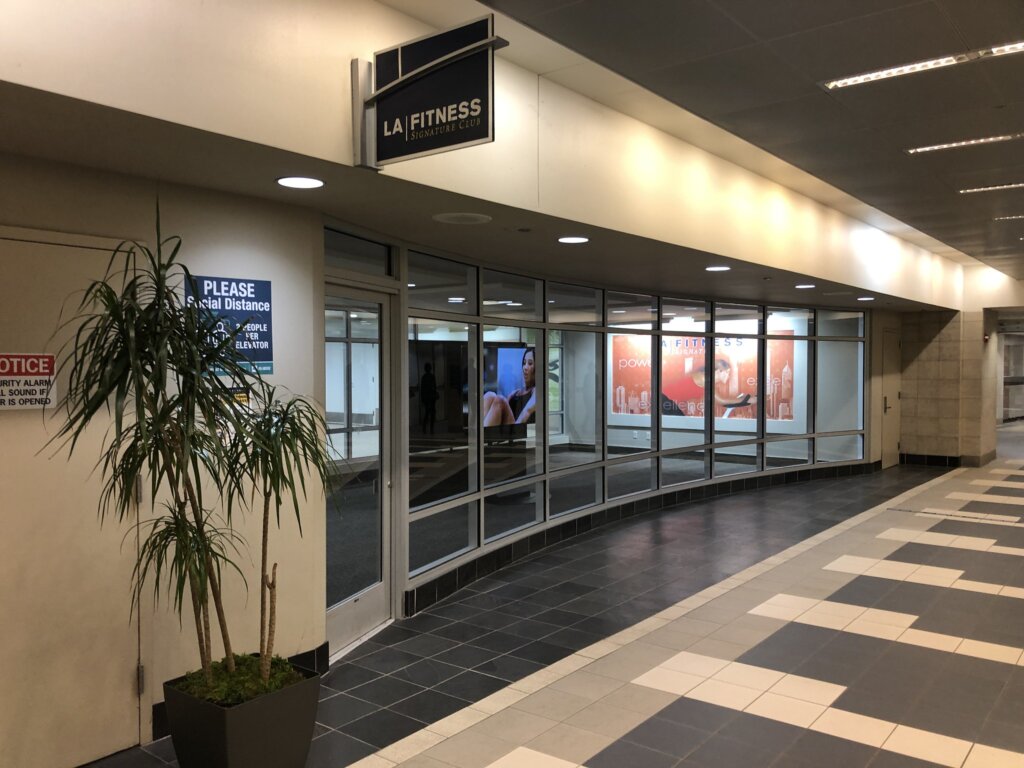
Macy’s Chicago
Macy’s Loop store, the second largest department store in the U.S., embraces the Pedway with four separate entrances at the sub-basement level, as well as a collection of 22 stained-glass windows that face the entrances on the opposite wall. In addition to shopping, Macy’s offers the iconic Walnut Room (the nation’s oldest continuously operating department store restaurant) and a Tiffany-designed tile ceiling with 1.6 million pieces of iridescent glass that is not to be missed.
City Hall/Cook County Building
If you have official business to take care of, the Pedway also goes to the City Hall/Cook County Building (Clark and Randolph Sts). While you’re there you can get a lot of things done (especially if you don’t have to carry your heavy winter coat around). You can visit Chicago’s mayor (if you’ve got enough clout to get past the guards in the lobby), pay your property taxes, apply for a liquor license, marvel at the fancy decor of the building, or get married. That’s right, get married. They’ve been marrying couples at City Hall for more than 100 years at Marriage Court, located on the Pedway at the north end of the building. If you time your visit just right, you may be asked to serve as a witness by some lovestruck couple.
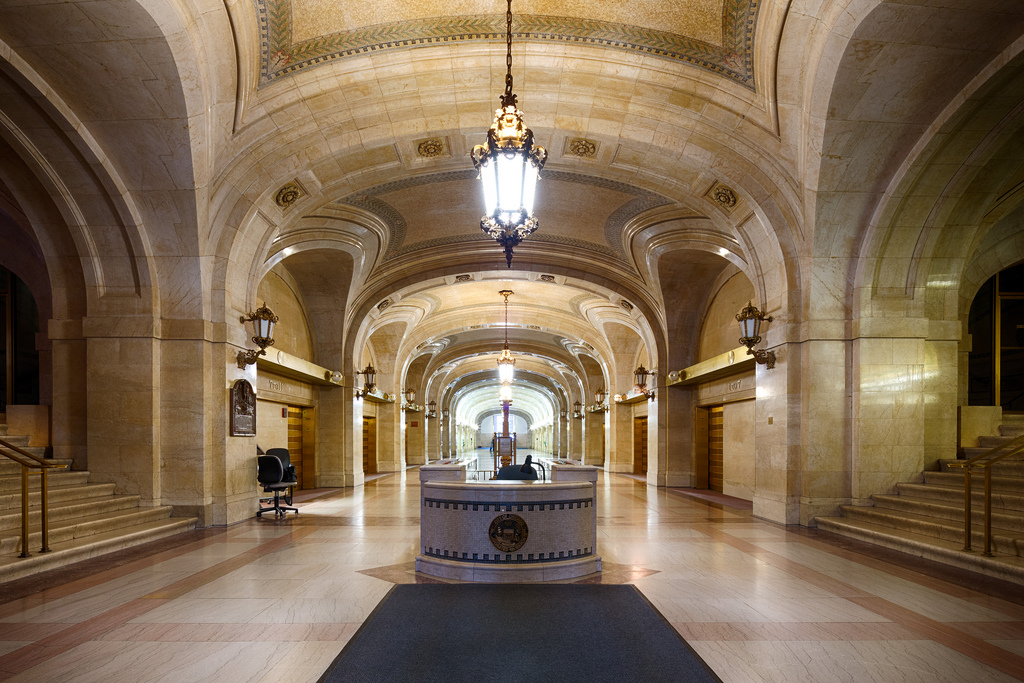
Millennium Station
The Pedway enters Millennium Station (formerly Randolph St. Station) in different spots, including lower Michigan Ave., the Prudential Building and the Cultural Center. If you need to catch a commuter train to Chicago’s southern suburbs or the South Shore Line to Gary or South Bend, Indiana, Millennium Station is your destination. A wide variety of food and beverages are available here for hungry, thirsty travelers.
AMC Dine-In Movies
If you’d like to watch a movie and get a bite to eat at the same time, take the Pedway to the Block 37 building (Washington and State Sts.) and head toward AMC Dine-in Movies, one of several entertainment options connected to the Pedway.

Cultural Center
The easiest way to enter the Cultural Center from the Pedway is to find the “golden elevator,” and take it up one floor to the lobby of the building. In addition to art exhibits, concerts, lectures and special events, the Cultural Center (Randolph St. and Michigan Ave.) is home to the world’s largest Tiffany Dome, as well as a second dome commissioned by the Grand Army of the Republic when the building was built (1895).
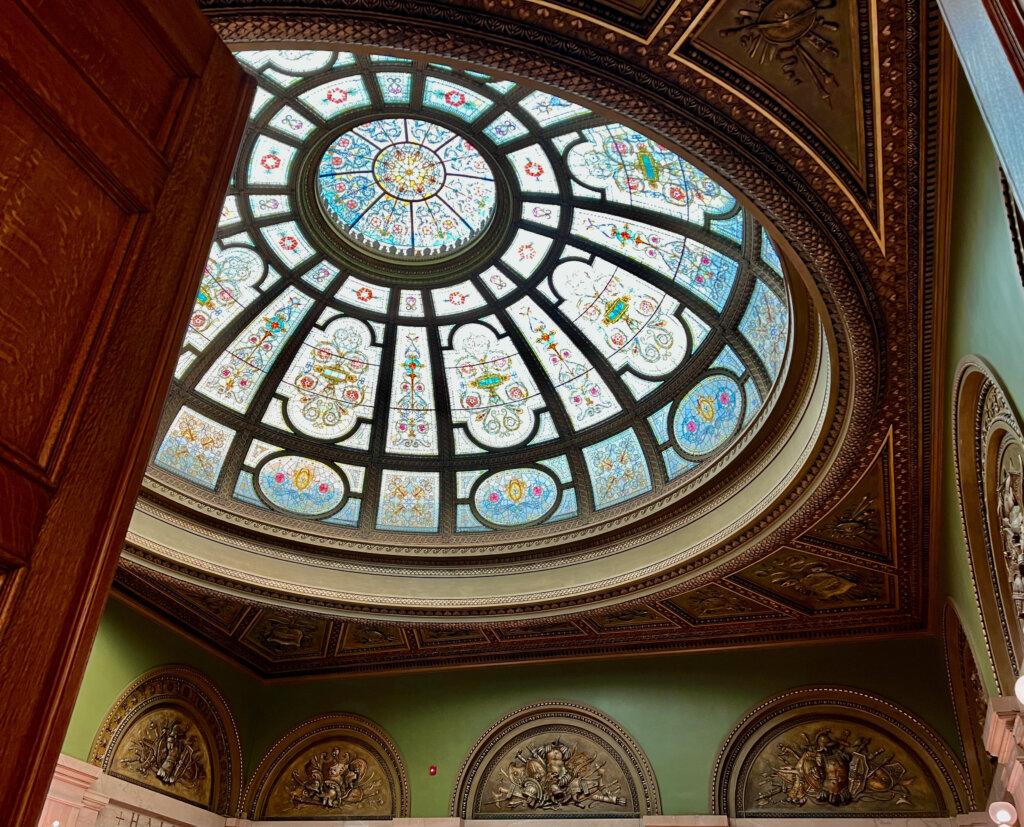
Red Line/Blue Line
Chicago’s two busiest L lines — the Red Line and the Blue Line — are not elevated when they pass through the Loop. They are subways that run parallel to one another one block apart (on State St. and Dearborn St. respectively). In 1951, two tunnels were dug between the two lines to enable passengers to cross from one line to the other. These tunnels became the first sections of Chicago’s Pedway and also served as inspiration for the construction of the entire system. To this day, these original Pedway tunnels are still in use, serving CTA passengers and Pedway walkers alike.
Chance the Rapper
Don’t miss a Pedway mural painted by student artists from the School of the Art Institute on lower Randolph St. (near Wabash). The artists were asked to select a contemporary who was up and coming in the performing arts and include him/her in the mural. They selected a then little-known artist — Chance the Rapper — now a global superstar who calls Chicago “home.”
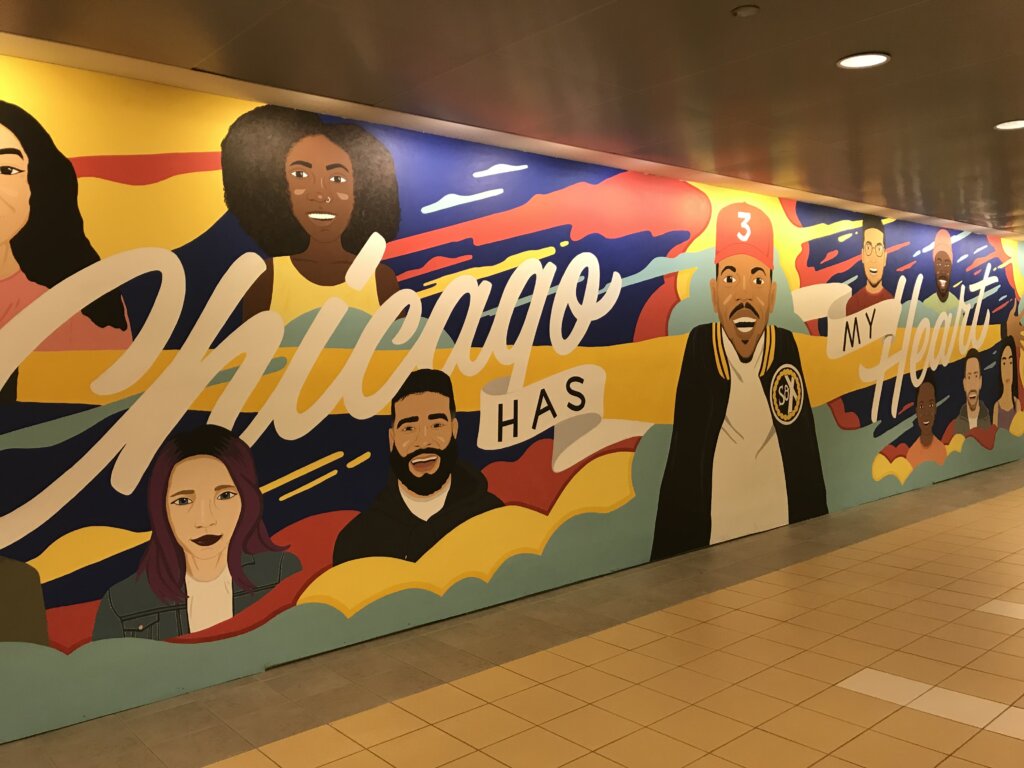
Daley Plaza
If you exit the Randolph St. Pedway at Dearborn St. by ascending the adjoining greystone stairs, you’ll find yourself in the middle of Richard J. Daley Plaza, home to several Chicago landmarks. Note the iconic, untitled sculpture by Pablo Picasso, a statue on Washington St. by Joan Miró, the Richard J. Daley Civic Center (offices and courtrooms) and the First United Methodist Church at Chicago Temple, a 23-story Gothic-style building which houses “Chapel in the Sky,” the world’s highest place of worship.
Lakeshore East Hotels
East of Michigan Ave. and north of Randolph St. is a newer city neighborhood known as Lakeshore East. If you’re interested in staying in a hotel that’s connected to the Pedway, this neighborhood has a wide array from which to choose — Swiss ô tel, Hyatt Regency, Fairmont, Radisson Blu Aqua and the St. Regis.
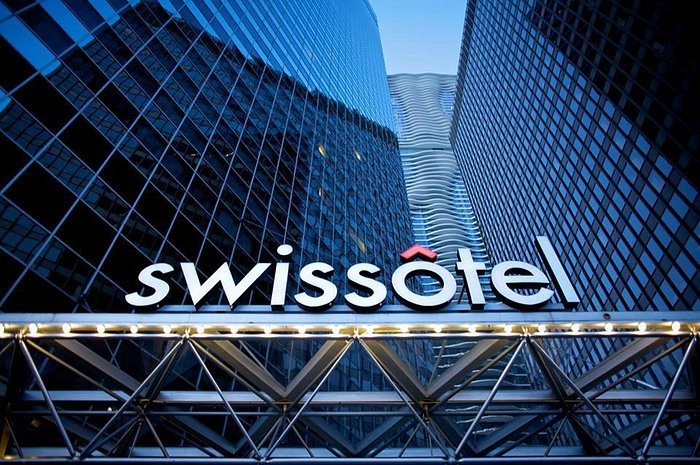
Located in the Pedway beneath the Prudential Building, Amazon Go allows you to purchase items without having to wait in line to check out. All you need is your phone and the company’s app — you select your items and then simply walk out of the store. It’s hassle free and convenient — just like the Pedway.
Harris Theatre
If you want to see a show and don’t want to travel outside to get there, take the Pedway east to Randolph St. and visit the Harris Theatre, Chicago’s home for music and dance productions of all types. The Harris Theatre is located at the north end of Millennium Park.
POPULAR TRIPS
Loop: home of the modern skyscraper.
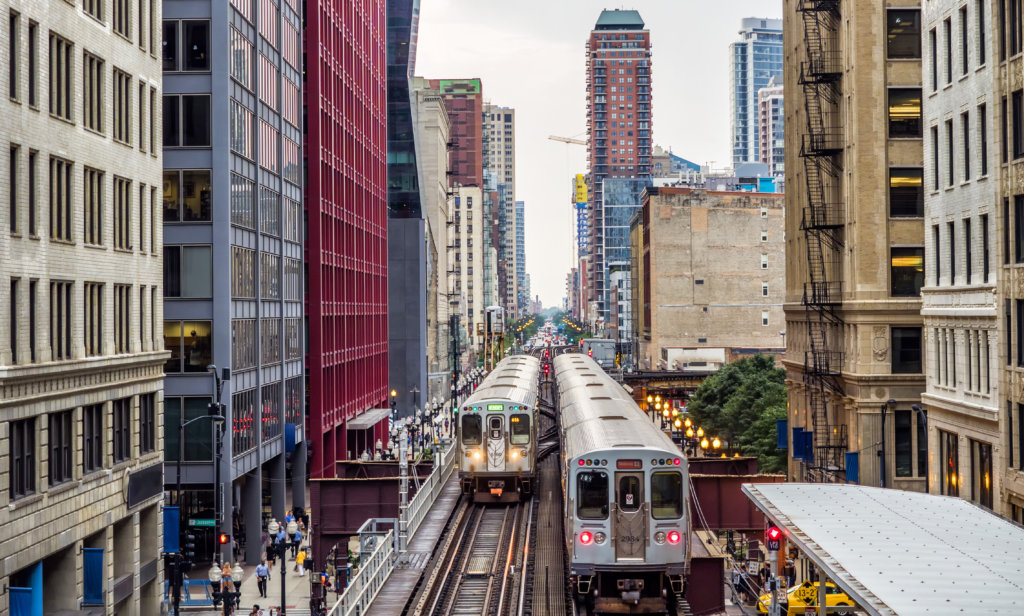
Duration: 3.5 hours
Price: Adult $60
- Tour price includes transit fees. Food/beverages purchased by guests.
- Tour begins and ends in the Loop.
- Walking distance: 1.5 miles
River North: Historic Pubs
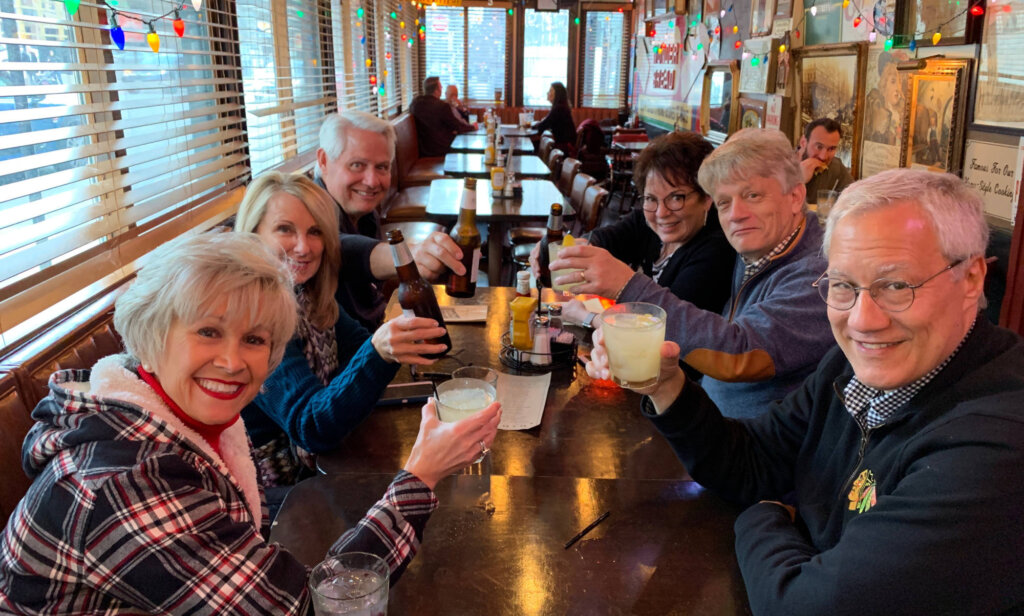
- Price includes transit fees. Food/beverages purchased by guests.
- Walking distance: 1.1 miles
Underground Chicago: Pedway Tour
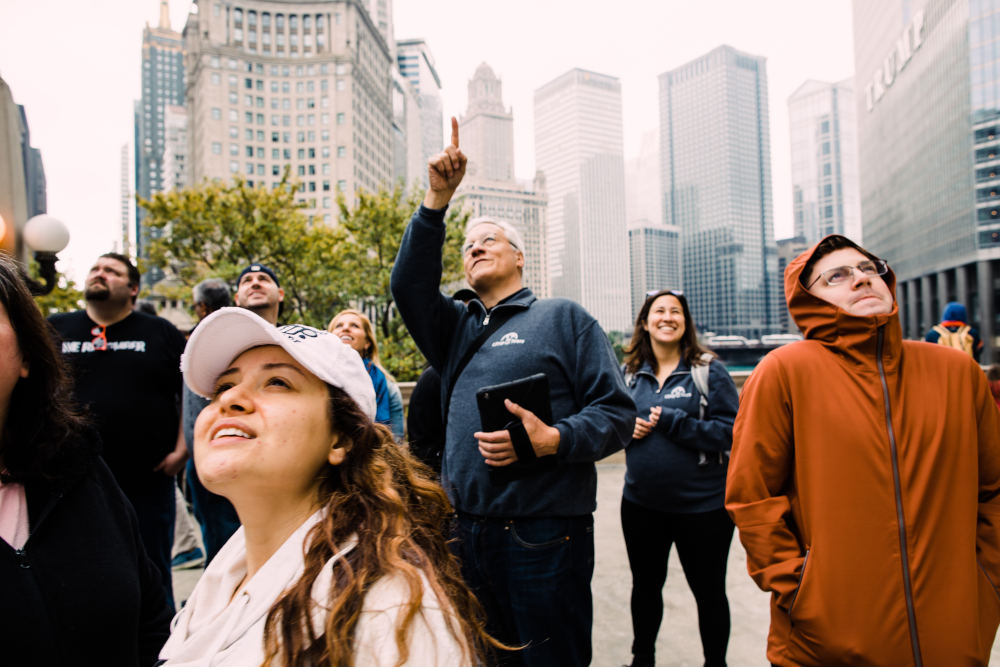
Duration: 2.5 hours
- Tour price includes professional tour guide, train ride. Food/beverages purchased by guests.
Stay in the LOOP and subscribe to our monthly newsletter today!
- Email This field is for validation purposes and should be left unchanged.

- This event has passed.
Tours & Attractions
Walking tour: open your eyes (chicago’s underground pedway & other secrets of the loop).
- Share this post:
Come experience Chicago’s famous “Pedway” – the mysterious underground tunnels downtown that keeps us all warm & dry in bad weather. Walking in the Pedway, through hidden corridors of stained glass and even underground swimming pools, we’ll access interiors that seem to come up out of nowhere as you’re exploring the tunnels. We’ll explore the hidden passages, overlooked details, rich symbolism, and quirky stories that add wonderful bits of color and texture to the overall narrative of the city. The details people walk by every day will amaze you, and you’ll feel like you’ve truly seen a hidden side of Chicago by the end of this walking tour. This is not a typical “must-see” tour for typical tourists – it’s a “must see” experience for travelers who want something BEYOND what’s typical. Is that you?
In addition to our underground wanderings to stunning architecture interiors, we will cover some “secrets” above ground, in plain sight. What are those giant green gargoyles on the library — and are they really gargoyles anyway? Did Picasso intend for his famous Daley Plaza sculpture to look like something — or someone — specific? Ending with a fabulous “secret” interior not far from the Art Institute, you’ll be in the perfect central spot for continuing your exploration of downtown Chicago on your own after the tour!
NOTE: Weekday and weekend offerings of this tour route vary slightly according to buildings’ hours of operation. But every tour explores main stretches of the Pedway, and treats guests to fabulous interiors and hidden secrets!
Return to events calendar
Recurring weekly on Sunday, Monday, Thursday, Friday and Saturday until Saturday December 23, 2023
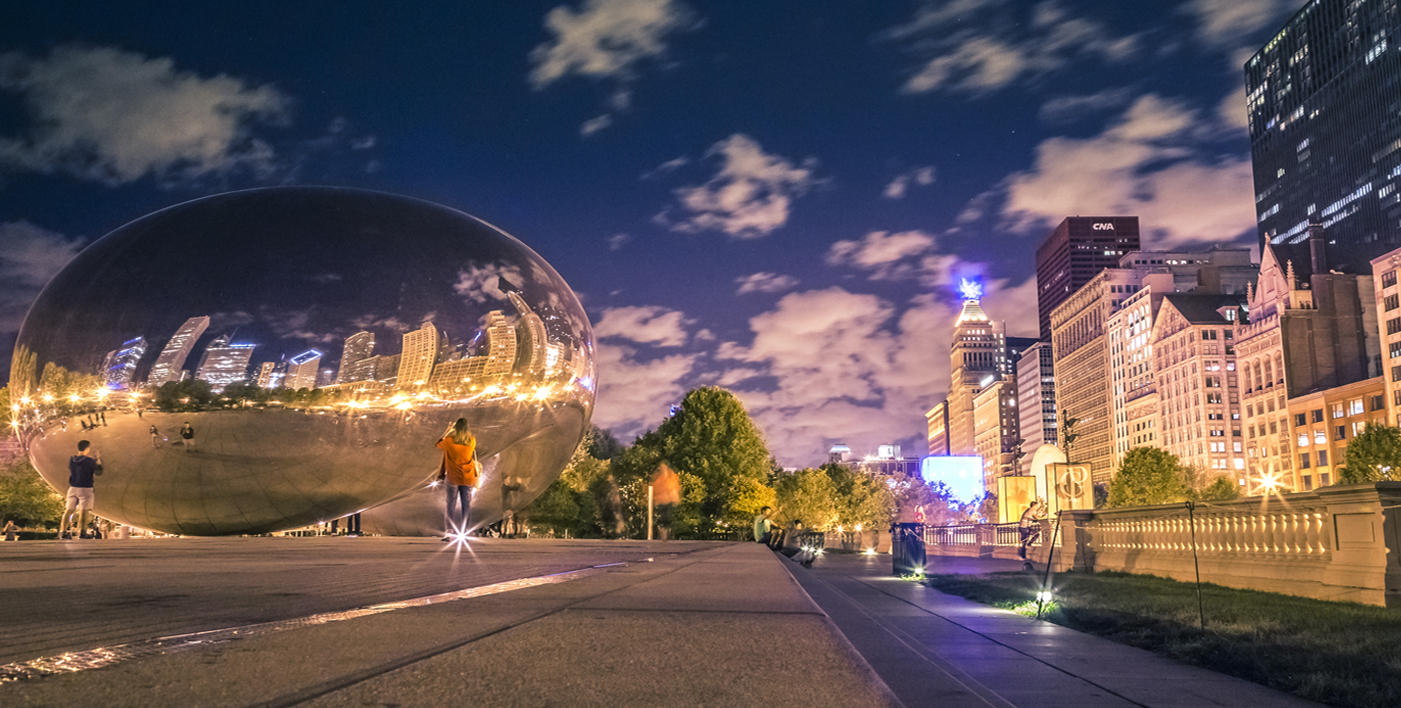
Explore hotels, flights, deals, and more
Plan your trip.
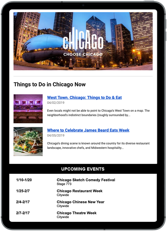
Chicago Newsletter
Stay in the know.
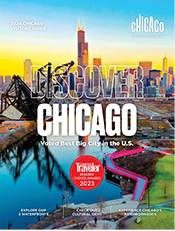
Visitors Guide
Start planning today.
Get the guide
Your Favorites
Quick access links.

Block Club Chicago
Your Neighborhood News Site
Underground Chicago Tour (Plus Rats!) Takes Visitors On A Stroll Through Chicago’s Underbelly

Share this:
- Click to share on Facebook (Opens in new window)
- Click to share on Reddit (Opens in new window)
- Click to share on Twitter (Opens in new window)
- Click to share on WhatsApp (Opens in new window)
- Click to email a link to a friend (Opens in new window)
Credibility:
- Original Reporting
- On the Ground
- Sources Cited

DOWNTOWN — Mike McMains, a Chicagoan known for his unique walking tours of the city, is going underground — and you can come along.
McMains’ Underground Chicago (Plus Rats!) Tour will showcase the city’s hidden underside and discuss how urban wildlife — namely rats — are a part of Chicago’s history. It’s set to kickoff July 22 and tickets are $30.
The 90-minute tour starts at the Ulta Beauty on the Magnificent Mile at 430 N. Michigan Ave. and ends at the Monroe Red Line stop, with several underground stops in between. McMains will discuss how Chicago’s history and architecture are closely intertwined with the rats who also call it home.
McMains, who operates Tours With Mike , often highlights Chicago’s architecture, design and history in tongue-in-cheek ways.
“For a long time, I’ve been fascinated by Chicago’s layers, that you have so much complexity going on above and below what the surface,” McMains said.
The idea for the tour originally came from a man who’d attended one of McMains’ Ugly Building tours , which highlights some of Chicago’s unsightly buildings.

He reached out to McMains to see if there was a tour that discusses the city’s rat history — inspired by his 10-year-old cousin’s fascination with the creatures. McMains himself already had an interest in Chicago’s underground streets, Pedway system and subway stations, and was looking for a way to make them more interesting for a tour.
“I was super excited and … the thing that I really loved about it is that you have a 10-year-old with a very unconventional interest,” McMains said. “And I just love that the family was coming together to rally behind this kid and say, ‘Hey, we’re not going to try to steer you towards something else so that you gonna blend in with society; we want to nurture and support your quirks and your interests.’ I love that they were like, ‘Hey, can you do this?’ I’m just like, ‘Absolutely, I want to do this.’”
For the tour, McMains heavily researched rat anatomy, behavior, and living patterns, including how the Norway brown rat made its way to Chicago from Asia centuries ago. McMains said he believes that rats are a great entryway to discussing Chicago’s underground history, especially since the species reflects some of the city’s best attributes.
“I really think that rats are so interconnected with the story of Chicago in that they’re adaptable, they’re resilient, they’re scrappy, and their fates are thoroughly interconnected with each other,” McMains said.
“If I didn’t get that random email earlier this year, I don’t think I would be doing this tour. I needed that spark in order to focus on the amazing underground infrastructure Chicago has. You need a story that binds it together, and those are rats.”
Stops on the tour include the Billy Goat Tavern at Lower Michigan Avenue, the Riverwalk and ports of Chicago, the history of the Downtown’s produce markets, the Illinois Central Railroad including Metra and CTA stations and more. People can also expect to see the parts of the Chicago Pedway and Wacker Drive where Christopher Nolan’s “The Dark Knight” was filmed.

McMains said it’s unlikely any rats will show up for the tour, since they’re most active after sunset. But there will be visual aids along the route to help discuss rats and their place in Chicago’s underground layers. There will also be plenty of rat traps to spot as well, he said.
McMains also has tours of Chicago’s best architectural hits, the Riverwalk and notable city interiors, plus app-based and virtual tours for those unable to make in-person walking tours or who want to take the lead themselves.
Public tours are available 1 p.m. on most Fridays and 10:30 a.m. Saturdays. Private tours can also be booked online.

McMains said people should expect an experience unlike any other tour that they’ve had before.
“Rats, sometimes rightly, have a negative image about them, people have a negative image of them,” McMains said. “But I think that they’re just absolutely fascinating creatures.
“To be able to have that interest in rats and how they’re just so compelling with their adaptations and everything, and how they’re just so connected to humans having that going with this ingenuity that we have in Chicago with these underground streets, underground subway stations with these underground pedestrian tunnels, it just it really clicks and fits together really well and I’m super excited to debut this tour to the public.”
Support Local News!
Subscribe to Block Club Chicago , an independent, 501(c)(3), journalist-run newsroom. Every dime we make funds reporting from Chicago’s neighborhoods. Already subscribe? Click here to gift a subscription , or you can support Block Club with a tax-deductible donation.
Listen to the Block Club Chicago podcast:

Maia McDonald
Twitter @maiamcdonld More by Maia McDonald

Chicago’s Forgotten Underground Freight Tunnels
- May 25, 2012
Beneath the skyscrapers of Chicago there is an unseen world that many Chicagoans are unaware of. Hidden deep below the skyscrapers of Chicago’s Loop are underground freight tunnels . I always assumed them to be a myth, but they are quite important to the history of the city of Chicago. The extent of these tunnels might be especially interesting for folks looking into in our Downtown Bucket List tour for private groups .
We research Chicago history and architecture like this while developing our live virtual events and custom corporate events. Join us for our public virtual events or book an exclusive team-building event for your private group . We can also create custom tours and original content creation about this Chicago topic and countless others.
Origins of the Underground Freight Tunnels
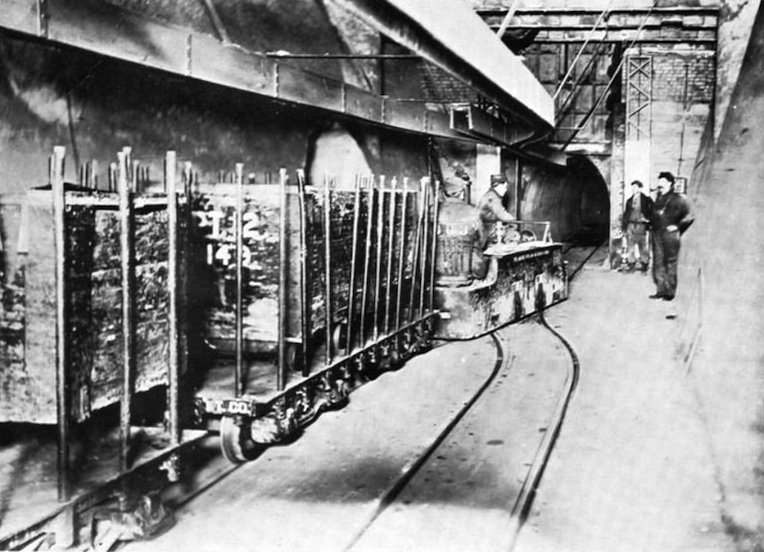
The Illinois Telephone and Telegraph Company built this expansive network of tunnels at the beginning of the twentieth century. Originally meant to hold telephone and telegraph cables, the project stalled after the Illinois Telephone and Telegraph Company ran out of money. In 1912 the Illinois Tunnel Company took over the underground construction and devised new uses for them for stores and warehouses. Stores like Marshall Fields could then move merchandise, packages and waste to and from their stores.
These tunnels are over forty feet below the surface of city streets. As discussed in “ Chicago’s Unique Underground” these tunnels are so far below ground that they are below the sewers, pipes, cables, wires, and conduits of the modern city. One of the largest benefits and incentives to use the tunnels was that they reduced traffic congestion on the streets of Chicago, especially in the Loop.
What’s the Use?!
Even when the tunnels were in use few people of the city of Chicago knew they existed beyond those who used them. When completed nearly sixty-two miles of tunnels criss-crossed underneath the city. The tunnels were six feet wide and 7.5 feet high with one-foot thick concrete walls. Overhead trolley wires powered them.
The tunnels also handled coal deliveries and other bulky cargoes. Most importantly the tunnels served as a way to remove the ashes and waste from coal-burning buildings and take them to the dump, and having the tunnels underground, where the burning was happening, was incredibly efficient. By moving shipping underground, these tunnels helped reduce street level traffic during times of intense congestion.
Where’d The Underground Freight Tunnels Go?
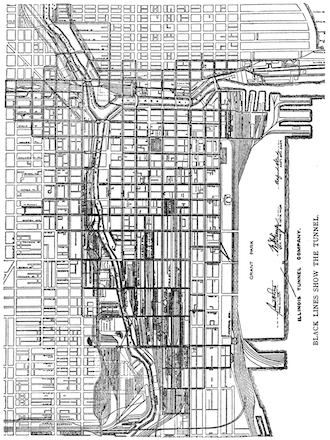
In the super intricate map, you can get a sense of how expansive this system really was. The tunnels encompassed the whole Loop area, and ran under nearly every street from the river down to sixteenth street. The tunnels even went south under the Illinois Central yards (the tracks that run through Grant Park today) as well as north of the river. To this day no other city has had a system of freight collection and delivery comparable to Chicago’s.
So you’re likely wondering, where are these tunnels now? Well most of them are still there. The tunnels stopped carrying cargo in 1959. They sat empty and forgotten for decades until 1992, when one of the tunnels under the Chicago River was punctured. The subsequent flooding inundated most of the system and two dozen downtown buildings with open tunnel connections.
Today, some sections of the tunnels are used for utility and communication lines. None of the tunnels have been used for the Pedway system, which does not go as far below ground level. Since they are so securely sealed up, it is unlikely that anything like “ Dark Days ” is going on down there. Finally, no, we do not and cannot tour the old freight tunnels. The city has had them well-sealed since the flood.
~Brian Failing: Research & Collections Intern
ABOUT CHICAGO DETOURS
In business since 2010, Chicago Detours is a passionate team of educators, historians and storytellers. We applied a decade of experience as one of Chicago’s top-rated tour companies to become a virtual event company in 2020. We bring curious people to explore, learn and interact about Chicago’s history, architecture and culture through custom tours, content production, and virtual events.
Chicago Detours is boutique tour company that tells neighborhood and city stories through in-person tours, virtual tours, and custom content for private group events.
- Architecture
- Chicago Art & Culture
- Chicago History
- Chicago Loop
- Chicago Neighborhoods
- Contemporary Chicago
- Detours News
- Food & Drink
- Travel & Events Industry
- Virtual Tours
In-person Private Tours!
Our small business tour company has been voted “Best Tour of Chicago” runner up for the past two years. Come see why!
Explore Tours
Interested in a virtual tour?
Our virtual tours uplift meetings and inspire connections for conferences, corporate groups, and universities.
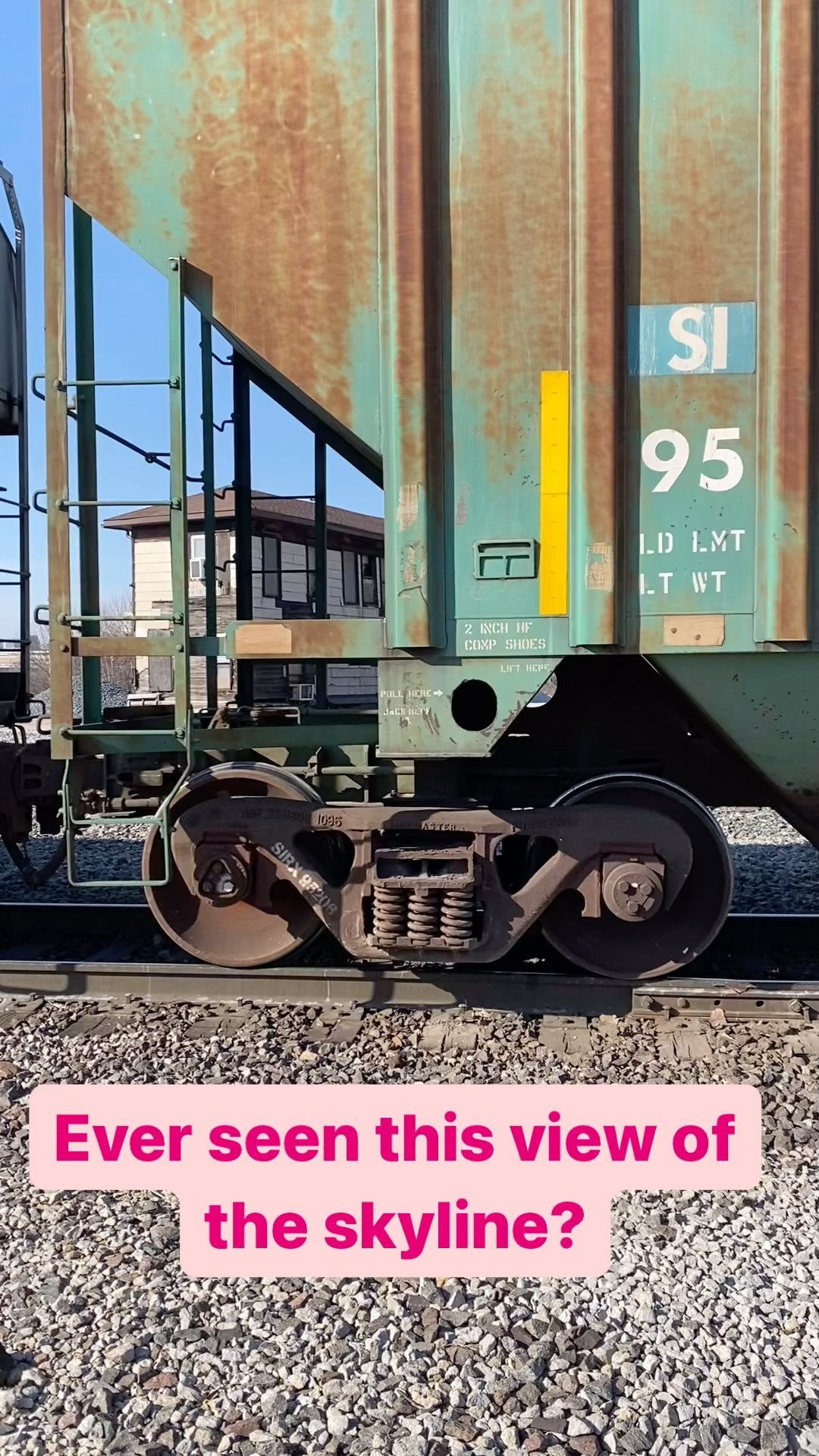
Sign up for news!
Related posts.

The ‘L’ – Roots of a Chicago Landmark
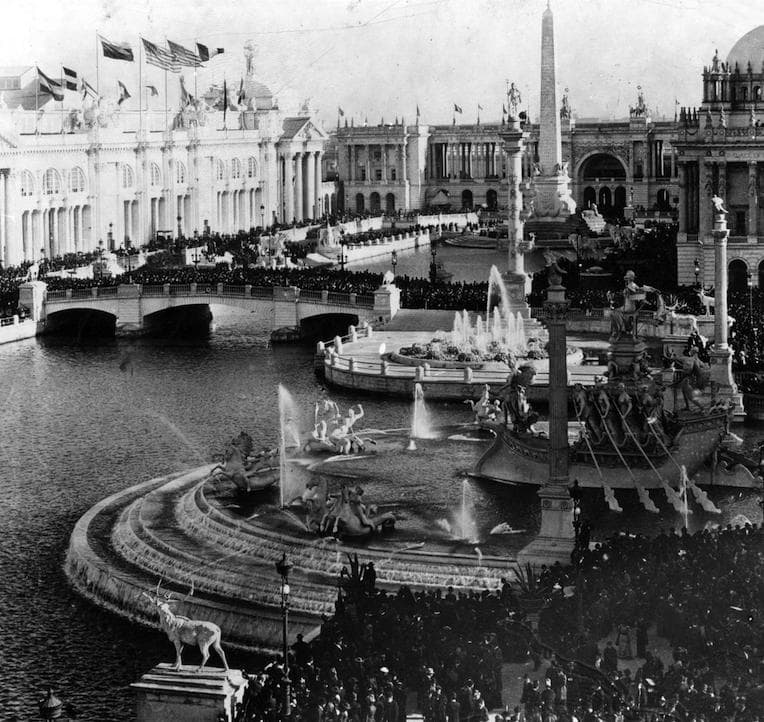
What Was the Opening Day of the 1893 World’s Fair Like?

Four Female Architects Who Shaped Chicago

Sip Hot Chocolate in These 4 Historic Spots
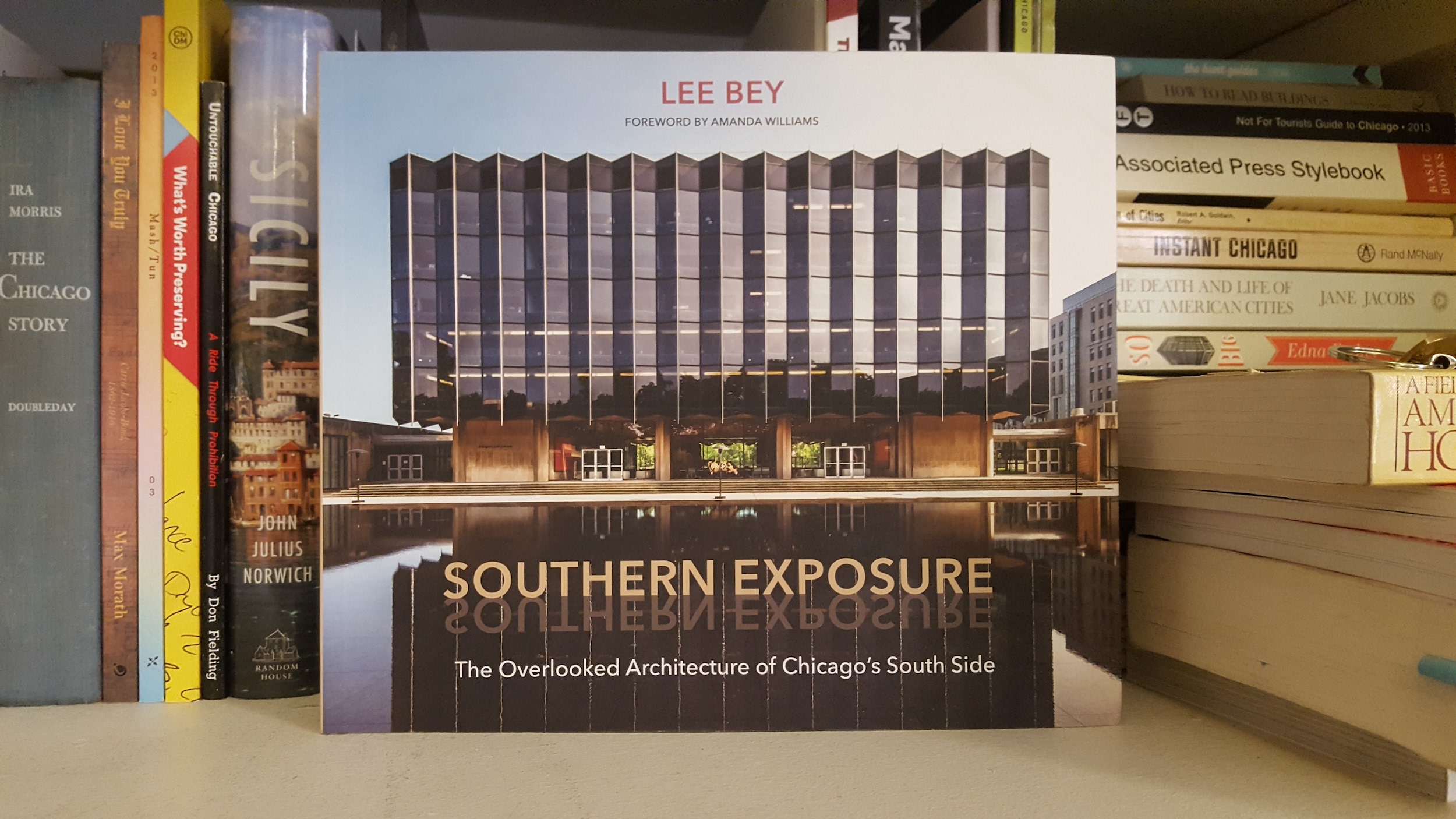
Best Chicago Books for Smart Holiday Gifts
Book a tour, latest from the blog.
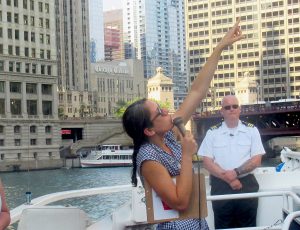
Tour Guides are Storytellers

© 2023 Chicago Detours
Privacy Policy | Terms & Conditions
be a curious person!
SIGN UP FOR OCCASIONAL UPDATES FROM CHICAGO DETOURS.

Private Tour Coordinator and Tour Guide
There is no shortage of things to discover in Chicago—I love being an urban explorer and uncovering its hidden places. I have an MA in Public History from Loyola University Chicago, and I have worked as a museum educator and kindergarten teacher. My desire to learn new things fuels my passion for educating others, which I get to experience every day as a Chicago tour guide. I live in the northern neighborhood of Rogers Park.

Whether you are a first-time visitor or a lifelong resident, the vibrant history and modern majesty of Chicago never ceases to amaze. I’m a graduate of Columbia College with an M.A. in Interdisciplinary Art. I’ve worked for many years as an educator at City Colleges of Chicago. As tour guide at Chicago Detours, I integrate my enthusiasm for culture and architecture with my passion as an educator. West Town/Noble Square area is home for me.

With our Chicago neighborhoods, vibrant cultural institutions and nearly two centuries of larger-than-life stories, there’s never a dull moment here! I’m a fifth generation Chicagoan and a graduate of Washington University in St. Louis. In addition to guiding tours, I’m a creative writer and amateur genealogist. I also enjoy the city’s dynamic theater scene. You can also read overlooked stories from 19th-century newspapers on my “Second Glance History” blog. I live in River North.

Chicago is unique as it always evolves into the future while holding on to the past. I’m fascinated by how people latch on to old architecture but happily pave over others. My background is in theater and performance and I’ve been a tour guide here for more than 10 years. Currently I’m finishing my Master’s in Public History at Loyola University because I love to teach the history of this scrappy city. I’m in the Edgewater neighborhood.

Operations Coordinator and Tour Guide
Chicago’s history is so fascinating, you could spend a lifetime uncovering its secrets…I’m willing to give it a try! I have an M.A. in US History from the University of Nevada-Las Vegas and then pursued doctoral studies in Urban History at the University of Illinois at Chicago. I love to learn new aspects of Chicago’s rich history and then share my knowledge as a tour guide with Chicago Detours. I live in Ravenswood.

Content Manager and Tour Guide
Chicago has so many neighborhoods, buildings, and by-ways that it’s hard to go long without seeing something new, or something familiar from a new angle. I studied Cinema History for my M.A. from the University of Chicago. I’ve worked as a culture writer for various publications and as an educator of the humanities at the City Colleges of Chicago. I’m thrilled to share my love of this city’s busy past and unique architectural spaces with Chicago Detours. I live in the Chicago neighborhood of Lincoln Park.

Amanda Scotese
Executive director and tour guide, book a chicago event.
Let’s Connect!

IMAGES
VIDEO
COMMENTS
These fascinating creatures have a lot in common with Chicago: they're scrappy, they're adaptable, they're resilient, and their fates are thoroughly interconnected. Underground Chicago (Plus Rats!) is a fun, one-of-a-kind tour experience where you'll explore an underground labyrinth discovering features people rarely notice and the ...
The Pedway System. This Pedway goes under Daley Center. The most user-friendly layer of Chicago's underground is the Pedway System. The term "Pedway" is a conjunction word formed from "pedestrian way.". A busy city like Chicago is always looking for ways to drop syllables for efficiency! Functionally, the Pedway is a collection of ...
In the mid-1800's, Chicago officials were seeking a better way to provide clean water for a booming population. The solution: a two-mile tunnel beneath Lake Michigan that could transport fresh water into the city, an innovative feat of engineering for the time. The tunnel was completed in 1866, along with the ornate Water Tower and Pumping ...
However, the city's downtown is perhaps best traveled by foot. It's the only way to explore a series of underground tunnels and bridges known as the Pedway that link more than 40 blocks in the ...
15 Nashville. 16 San Diego. 17 Niagara Falls, USA. 18 Everglades City. 19 St. Augustine, Florida. 20 San Antonio. Explore downtown Chicago through its underground passageways, known as "The Pedway," accessing beautiful interiors from both above ground and below, with secrets along the way, on a walking tour.
Come experience Chicago's famous "Pedway" - the mysterious underground tunnels downtown that keep us all warm & dry in bad weather. Walking in the Pedway, through hidden corridors of stained glass and even past underground swimming pools, we'll access interiors that seem to come up out of nowhere as you're exploring the tunnels.
February 20 2004. Subterranean City: A Tour of Chicago's Pedway (Part Two) The Pedway is often called Chicago's secret weapon against the elements. Made up of a combination of underground tunnels, concourses and overhead skyway bridges, the pedestrian walkway network provides shelter from all types of inclement weather in and around the Loop.
Discover a lesser-known side of the Windy City on this Chicago Pedway tour, a walking excursion through the many heated passageways, tunnels, and corridors that link some of the town's most iconic buildings. Follow your humorous guide on an insider's exploration of these relatively unknown walkways, learning about the area's architecture and history as you go. It's a great way to explore a ...
The Pedway is a series of mostly indoor tunnels, bridges, and paths throughout downtown Chicago. Construction of this labyrinth began in 1951 to simply connect the Red and Blue line subway/'L' train stops. Now it connects over 50 buildings, 40 blocks, and 5 miles of pathways. While on this tour, we will see Chicago's famous architecture while ...
You will also experience the interiors of a few of Chicago's famous historic and contemporary buildings. ... Behind the Tour: The Chicago Pedway. 111 E. Wacker Drive Chicago, IL 60601. 312.922.3432. [email protected]. Open 7 days a week, 10 a.m. - 5 p.m. Stay Connected Subscribe.
Lorie Westerman is a CAC docent, a Pedway tour director, and the designer of CAC's Pedway tours. She became fascinated by the Pedway when she moved to the city in 2003 and decided to delve into the story behind how it came to be. Winter in Chicago can make navigating downtown a challenge, even for lifelong residents of the city.
The tour ends with the "secret" interior of the Art Institute where guests are well positioned to explore more of downtown Chicago after the tour. Cost: Adults $30.00, Children $25.00. Duration: Around 2 Hours. Distance: Around 1.5 Miles Of Walking. Group Size: Up To 15 People.
Chicago underground tours connect past and present beneath Windy City streets. In the days of the Prohibition, Chicago gangsters like Al Capone used underground tunnels for illicit activities and ...
The Underground Chicago Walk is a tour through Chicago's pedway, a little-known underground tunnel system in the heart of downtown Chicago — with food samples included. It may sound scary but fear not, the recently rehabbed tunnels are used by thousands of savvy locals every day. Purchase half-price tickets to this event.
Then, we will head underground visiting City Hall, The Picasso, Block 37, Macy's and many other attractions on our walk. Along the way, we will venture out of the tunnels and view some of the wonderful skyscrapers connected to the Pedway system. We will stop for coffee and pastries at the half way point and discuss the places we have visited.
Chicago, IL8,761 contributions. Nearly five miles of underground pedestrian walkway. Nov 2018. The Chicago Pedway is a network of pedestrian tunnels, ground-level concourses and bridges connecting skyscrapers, retail stores, hotels and train stations throughout the central business district of Chicago.
A different approach to map-making is necessary to elucidate the Pedway System. This map designed by my tour company, Chicago Detours, is a helpful guide with the user experience in mind as it includes all kinds of tips on navigating the system. In addition to showing the passages, this map marks all stairways and buildings that connect with ...
May 15, 2023. Chicago is a great walking city — even if you're walking underground. With Chicago's Pedestrian Walkway system (Pedway), a six-mile system of underground tunnels, pathways and connected corridors, it's possible to walk from one side of the Loop to the other without encountering traffic, nasty weather, special events or ...
Come experience Chicago's famous "Pedway" - the mysterious underground tunnels downtown that keeps us all warm & dry in bad weather. Walking in the Pedway, through hidden corridors of stained glass and even underground swimming pools, we'll access interiors that seem to come up out of nowhere as you're exploring the tunnels.
Chicago's downtown pedestrian way system, the Pedway, lies in the heart of the city. This system of underground tunnels and overhead bridges links more than 40 blocks in the Central Business District, covering roughly five miles. Used by tens of thousands of pedestrians each day, the Pedway connects to public and private buildings, CTA ...
Tour will showcase the city's hidden underside and discuss how urban wildlife — namely rats — are a part of Chicago's history. It's set to kickoff July 22 and tickets are $30. The 90-minute tour starts at the Ulta Beauty on the Magnificent Mile at 430 N. Michigan Ave. and ends at the Monroe Red Line stop, with several underground ...
Chicago Pedway. Coordinates: 41°53′03.2″N 87°37′28.7″W. OpenStreetMap map of the Pedway. Sign of the Chicago Pedway. An underground Pedway tunnel. Inside a Pedway bridge between the Ogilvie Transportation Center and 2 North Riverside Plaza. The Chicago Pedway is a network of tunnels, ground-level concourses and bridges in Chicago ...
Even when the tunnels were in use few people of the city of Chicago knew they existed beyond those who used them. When completed nearly sixty-two miles of tunnels criss-crossed underneath the city. The tunnels were six feet wide and 7.5 feet high with one-foot thick concrete walls. Overhead trolley wires powered them.